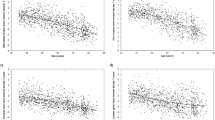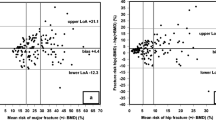Abstract
Summary
A diverse array of bone density, structure, and strength parameters were significantly associated with distal forearm fractures in postmenopausal women, but most of them were also correlated with femoral neck areal bone mineral density (aBMD), which provides an adequate measure of bone fragility at the wrist for routine clinical purposes.
Introduction
This study seeks to test the clinical utility of approaches for assessing forearm fracture risk.
Methods
Among 100 postmenopausal women with a distal forearm fracture (cases) and 105 with no osteoporotic fracture (controls), we measured aBMD and assessed radius volumetric bone mineral density, geometry, and microstructure; ultradistal radius failure load was evaluated in microfinite element (μFE) models.
Results
Fracture cases had inferior bone density, geometry, microstructure, and strength. The most significant determinant of fracture in five categories were bone density (femoral neck aBMD; odds ratio (OR) per standard deviation (SD), 2.0; 95% confidence interval (CI), 1.4–2.8), geometry (cortical thickness; OR, 1.5; 95% CI, 1.1–2.1), microstructure (structure model index (SMI); OR, 0.5; 95% CI, 0.4–0.7), and strength (µFE failure load; OR, 1.8; 95% CI, 1.3–2.5); the factor-of-risk (applied load in a forward fall ÷ μFE failure load) was 15% worse in cases (OR, 1.9; 95% CI, 1.4–2.6). Areas under receiver operating characteristic curves (AUC) ranged from 0.62 to 0.68. The predictors of forearm fracture risk that entered a multivariable model were femoral neck aBMD and SMI (combined AUC, 0.71).
Conclusions
Detailed bone structure and strength measurements provide insight into forearm fracture pathogenesis, but femoral neck aBMD performs adequately for routine clinical risk assessment.

Similar content being viewed by others
References
van Lenthe GH, Müller R (2008) CT-based visualization and quantification of bone microstructure in vivo. IBMS BoneKEy 5:410–425
Boutroy S, Bouxsein ML, Munoz F et al (2005) In vivo assessment of trabecular bone microarchitecture by high-resolution peripheral quantitative computed tomography. J Clin Endocrinol Metab 90:6508–6515
Melton LJ III, Riggs BL, van Lenthe GH et al (2007) Contribution of in vivo structural measurements and load/strength ratios to the determination of forearm fracture risk in postmenopausal women. J Bone Miner Res 22:1442–1448
Sornay-Rendu E, Boutroy S, Munoz F et al (2007) Alterations of cortical and trabecular architecture are associated with fractures in postmenopausal women, partially independent of decreased BMD measured by DXA: the OFELY study. J Bone Miner Res 22:425–433
Arbenz P, van Lenthe GH, Mennel U et al (2008) A scalable multi-level preconditioner for matrix-free micro-finite element analysis of human bone structures. Int J Numer Methods Eng 73:927–947
Parfitt AM (1984) Age-related structural changes in trabecular and cortical bone: cellular mechanisms and biomechanical consequences. Calcif Tissue Int 36(Suppl 1):S123–128
Palvanen M, Kannus P, Parkkari J et al (2000) The injury mechanisms of osteoporotic upper extremity fractures among older adults: a controlled study of 287 consecutive patients and their 108 controls. Osteoporos Int 11:822–831
Melton LJ III, Amadio PC, Crowson CS et al (1998) Long-term trends in the incidence of distal forearm fractures. Osteoporos Int 8:341–348
Riggs BL, Melton LJ III, Robb RA et al (2006) Population-based analysis of the relationship of whole bone strength indices and fall-related loads to age- and sex-specific patterns of hip and wrist fractures. J Bone Miner Res 21:315–323
Kirmani S, Christen D, van Lenthe GH et al (2009) Bone structure at the distal radius during adolescent growth. J Bone Miner Res 24:1033–1042
Laib A, Hauselmann HJ, Ruegsegger P (1998) In vivo high resolution 3D-QCT of the human forearm. Technol Health Care 6:329–337
Parfitt AM, Drezner MK, Glorieux FH et al (1987) Bone histomorphometry: standardization of nomenclature, symbols, and units. Report of the ASBMR Histomorphometry Nomenclature Committee. J Bone Miner Res 2:595–610
Laib A, Newitt DC, Lu Y et al (2002) New model-independent measures of trabecular bone structure applied to in vivo high-resolution MR images. Osteoporos Int 13:130–136
Laib A, Ruegsegger P (1999) Calibration of trabecular bone structure measurements of in vivo three-dimensional peripheral quantitative computed tomography with 28-mm-resolution microcomputed tomography. Bone 24:35–39
MacNeil JA, Boyd SK (2007) Accuracy of high-resolution peripheral quantitative computed tomography for measurement of bone quality. Med Eng Phys 29:1096–1105
van Lenthe GH, Müller R (2006) Prediction of failure load using micro-finite element analysis models: toward in vivo strength assessment. Drug Discov Today Tech 3:221–229
Pistoia W, van Rietbergen B, Lochmuller EM et al (2002) Estimation of distal radius failure load with micro-finite element analysis models based on three-dimensional peripheral quantitative computed tomography images. Bone 30:842–848
Bouxsein ML (2008) Chapter 23. Biomechanics of age-related fractures. In: Marcus R, Feldman D, Nelson DA, Rosen CJ (eds) Osteoporosis, 3rd edn. Elsevier, Amsterdam, pp 601–623
Chiu J, Robinovitch SN (1998) Prediction of upper extremity impact forces during falls on the outstretched hand. J Biomech 31:1169–1176
Harrell FE Jr, Lee KL, Mark DB (1996) Multivariable prognostic models: issues in developing models, evaluating assumptions and adequacy, and measuring and reducing errors. Stat Med 15:361–387
DeLong ER, DeLong DM, Clarke-Pearson DL (1988) Comparing the areas under two or more correlated receiver operating characteristic curves: a nonparametric approach. Biometrics 44:837–845
Raisz LG (2005) Clinical practice. Screening for osteoporosis. N Engl J Med 353:164–171
Nelson HD, Helfand M, Woolf SH et al (2002) Screening for postmenopausal osteoporosis: a review of the evidence for the U.S. Preventive Services Task Force. Ann Intern Med 137:529–541
Genant HK, Jiang Y (2006) Advanced imaging assessment of bone quality. Ann N Y Acad Sci 1068:410–428
Seeman E, Delmas PD (2006) Bone quality–the material and structural basis of bone strength and fragility. N Engl J Med 354:2250–2261
NOF Guide Committee (2008) Clinician’s Guide to Prevention and Treatment of Osteoporosis National Osteoporosis Foundation. http://www.nof.org/professionals/NOF_Clinicians_Guide.pdf, Washington, D.C.
Sode M, Burghardt AJ, Nissenson RA et al (2008) Resolution dependence of the non-metric trabecular structure indices. Bone 42:728–736
Vico L, Zouch M, Amirouche A et al (2008) High-resolution pQCT analysis at the distal radius and tibia discriminates patients with recent wrist and femoral neck fractures. J Bone Miner Res 23:1741–1750
Cummings SR, Melton LJ III (2002) Epidemiology and outcomes of osteoporotic fractures. Lancet 359:1761–1767
Khosla S, Riggs BL, Atkinson EJ et al (2006) Effects of sex and age on bone microstructure at the ultradistal radius: a population-based noninvasive in vivo assessment. J Bone Miner Res 21:124–131
Lochmuller EM, Matsuura M, Bauer J et al (2008) Site-specific deterioration of trabecular bone architecture in men and women with advancing age. J Bone Miner Res 23:1964–1973
Boutroy S, Van Rietbergen B, Sornay-Rendu E et al (2008) Finite element analysis based on in vivo HR-pQCT images of the distal radius is associated with wrist fracture in postmenopausal women. J Bone Miner Res 23:392–399
Muller ME, Webber CE, Bouxsein ML (2003) Predicting the failure load of the distal radius. Osteoporos Int 14:345–352
Ashe MC, Khan KM, Kontulainen SA et al (2006) Accuracy of pQCT for evaluating the aged human radius: an ashing, histomorphometry and failure load investigation. Osteoporos Int 17:1241–1251
Parfitt AM (1994) The two faces of growth: benefits and risks to bone integrity. Osteoporos Int 4:382–398
Riggs BL, Parfitt AM (2005) Drugs used to treat osteoporosis: the critical need for a uniform nomenclature based on their action on bone remodeling. J Bone Miner Res 20:177–184
Cooper D, Turinsky A, Sensen C et al (2007) Effect of voxel size on 3D micro-CT analysis of cortical bone porosity. Calcif Tissue Int 80:211–219
Wachter NJ, Augat P, Krischak GD et al (2001) Prediction of cortical bone porosity in vitro by microcomputed tomography. Calcif Tissue Int 68:38–42
Buie HR, Campbell GM, Klinck RJ et al (2007) Automatic segmentation of cortical and trabecular compartments based on a dual threshold technique for in vivo micro-CT bone analysis. Bone 41:505–515
Riggs BL, Khosla S, Melton LJ III (2002) Sex steroids and the construction and conservation of the adult skeleton. Endocr Rev 23:279–302
Kaptoge S, Benevolenskaya LI, Bhalla AK et al (2005) Low BMD is less predictive than reported falls for future limb fractures in women across Europe: results from the European Prospective Osteoporosis Study. Bone 36:387–398
MacNeil JA, Boyd SK (2008) Bone strength at the distal radius can be estimated from high-resolution peripheral quantitative computed tomography and the finite element method. Bone 42:1203–1213
Kelsey JL, Prill MM, Keegan TH et al (2005) Reducing the risk for distal forearm fracture: preserve bone mass, slow down, and don’t fall! Osteoporos Int 16:681–690
Melton LJ III, Achenbach SJ, O’Fallon WM et al (2002) Secondary osteoporosis and the risk of distal forearm fractures in men and women. Bone 31:119–125
Nielsen SP, Xie X, Barenholdt O (2001) Geometric properties of distal radius and pathogenesis of Colles fracture: a peripheral quantitative computed tomography study. J Clin Densitom 4:209–219
Eckstein F, Kuhn V, Lochmuller EM (2004) Strength prediction of the distal radius by bone densitometry–evaluation using biomechanical tests. Ann Biomed Eng 32:487–503
Mueller TL, van Lenthe GH, Stauber M et al (2006) Non-destructive prediction of individual bone strength as assessed by high-resolution 3D-pQCT in a population study of the human radius. J Bone Miner Res 21(Supplement 1):S232
Weichetova M, Stepan JJ, Haas T et al (2005) The risk of Colles’ fracture is associated with the collagen I alpha1 Sp1 polymorphism and ultrasound transmission velocity in the calcaneus only in heavier postmenopausal women. Calcif Tissue Int 76:98–106
Acknowledgments
The authors would like to thank Margaret Holets for the HRpQCT measurements, Lisa McDaniel, R.N. and Louise McCready, R.N., for their assistance in recruiting and managing the study subjects, James M. Peterson for his assistance with data management and file storage, and Mary Roberts for her assistance in preparing the manuscript.
Conflicts of interest
None.
Author information
Authors and Affiliations
Corresponding author
Additional information
This work was supported by research grants R01-AR027065 and UL1-RR024150 (Center for Translational Science Activities) from the National Institutes of Health, U.S. Public Health Service. Supercomputer time was granted by the Swiss National Supercomputing Centre.
Rights and permissions
About this article
Cite this article
Melton, L.J., Christen, D., Riggs, B.L. et al. Assessing forearm fracture risk in postmenopausal women. Osteoporos Int 21, 1161–1169 (2010). https://doi.org/10.1007/s00198-009-1047-2
Received:
Accepted:
Published:
Issue Date:
DOI: https://doi.org/10.1007/s00198-009-1047-2




